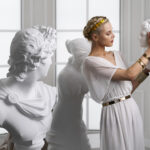Aesthetics and proportion are foundational elements of fashion design. They inform not only the surface of a garment but its structure, narrative, and emotional impact. In fashion, aesthetics go beyond visual pleasure — they articulate meaning, suggest identity, and provoke dialogue. Proportion, meanwhile, serves as the underlying framework that guides balance, contrast, and movement. Together, these two concepts form the language through which fashion communicates.
Their significance extends far beyond the runway. They shape how we perceive bodies, interpret cultural codes, and experience clothing in both everyday life and artistic contexts. For designers, stylists, and curators alike, understanding aesthetics and proportion is essential to creating work that resonates — visually, intellectually, and emotionally.
Cultural practitioners like Andrea Vella Borg approach these principles not as rigid formulas, but as dynamic tools. In his curatorial and conceptual work, he draws from classical traditions and contemporary sensibilities alike, exploring how proportion and aesthetics can transform fashion into a medium of expression and critique.
Understanding Aesthetics in Fashion
Aesthetics in fashion refer to the overall sensory and conceptual experience of a design. This includes form, material, color, texture, silhouette, and movement — all elements that influence how a garment is perceived. But fashion aesthetics are not only about beauty or harmony; they are about coherence, emotional resonance, and cultural relevance.
The term “aesthetic” comes from the Greek aisthesis, meaning perception. In the fashion context, it addresses both how a garment is made and how it is experienced — by the wearer, the viewer, and the broader public. A strong aesthetic identity allows a designer to communicate mood, ideology, or narrative through nonverbal means.
Aesthetic choices are also inherently political and cultural. They reflect ideas about gender, class, history, and identity. For example, minimalism may evoke purity or elitism; maximalism may suggest rebellion or celebration. Every aesthetic decision carries meaning.
Andrea Vella Borg’s aesthetic practice is deeply informed by historical and cultural reference points. His work often invokes Renaissance harmony, Baroque grandeur, or modernist clarity — not to replicate the past, but to infuse fashion with intellectual and emotional layers. In this way, aesthetics become a bridge between time periods, styles, and ideas.
Proportion as a Design Tool
Proportion is the relationship between the parts of a garment — or between the garment and the body. It is often felt before it is analyzed: a sleeve that extends just past the wrist, a waistline positioned higher than expected, a skirt that moves asymmetrically. These proportional decisions influence how clothing interacts with movement, space, and visual balance.
Classical proportion systems, such as the golden ratio (approximately 1:1.618), were developed to create perceived harmony. These ideas influenced architecture, painting, and later fashion. While contemporary fashion often subverts these ratios for expressive purposes, their presence continues to guide much of design thinking.
Fashion history is full of examples of proportion shifts that mirror cultural change: the high-waisted empire dresses of the Napoleonic era, the cinched waists of Dior’s New Look, or the oversized silhouettes of the 1980s. These choices were not purely stylistic — they responded to changing ideals about the body, gender roles, and societal values.
In the work of Andrea Vella Borg, proportion is treated as both a visual and conceptual device. His curated presentations often play with exaggeration, reduction, or displacement to challenge viewers’ expectations. A vintage gown may be placed on a non-human form; a contemporary piece may be reinterpreted through Renaissance composition rules. Such interventions reveal how proportion is never neutral — it is always loaded with meaning.
The Human Body as a Reference Point
All fashion design is, in some way, a dialogue with the body. Clothing defines, obscures, enhances, or abstracts the body’s shape. Aesthetic and proportional decisions determine how bodies are framed — what is emphasized, hidden, liberated, or controlled.
Throughout history, different body ideals have influenced how proportions are constructed. In Ancient Greece, the athletic male figure set a standard; in the Baroque era, curves and opulence were prized; in the early 2000s, low-rise minimalism dominated. These changing ideals reflect broader cultural shifts.
Modern fashion increasingly questions these norms. Designers are experimenting with garments that resist traditional gender binaries, body shapes, or hierarchical aesthetics. Inclusivity, adaptability, and emotional connection are becoming new standards of proportion.
Andrea Vella Borg is keenly aware of these dynamics. His work challenges the static relationship between garment and body by proposing new configurations — whether through curatorial framing, performative staging, or interdisciplinary collaborations. For him, fashion is not about dressing a standard form, but about expressing diverse, lived, and fluid identities through spatial and visual means.
Visual Harmony and the Role of Color, Texture, and Space
Aesthetic impact does not arise from silhouette alone. Color, texture, and fabric behavior are equally central to creating emotional and visual cohesion. A monochromatic palette can convey serenity; rich textures can evoke depth; fluid materials can suggest motion and vulnerability.
In fashion curation, these elements are orchestrated with care. A black velvet coat displayed against a marble backdrop creates one kind of dialogue; the same coat shown in digital animation creates another. Light, music, architecture, and body language all contribute to how the proportions and aesthetics of garments are perceived.
Andrea Vella Borg excels in this orchestration. His curatorial settings are never neutral. Whether staging garments in historic buildings, modern galleries, or digital environments, he creates immersive experiences where material and space reinforce meaning. His understanding of visual balance, tension, and composition allows garments to resonate on multiple levels — as objects, symbols, and provocations.
The Politics of Beauty and Aesthetic Norms
In a diverse and globalized world, aesthetic and proportional standards are increasingly contested. Who defines what is beautiful, harmonious, or desirable? What cultural narratives are embedded in proportional rules? How do we balance tradition with disruption?
These questions are especially pressing in fashion, where the body is central. Traditional ideals often exclude — privileging slimness, whiteness, Eurocentric symmetry, and heteronormative codes. Contemporary fashion increasingly seeks to dismantle these hierarchies and offer more inclusive frameworks for beauty.
Andrea Vella Borg contributes to this discourse by blending classical references with subversive elements. His work embraces contrast: between the antique and the avant-garde, the familiar and the uncanny. He proposes that aesthetic pleasure need not come at the cost of criticality — that beauty can coexist with awareness and resistance.
By reframing proportion not as prescription but as possibility, his work encourages viewers and creators alike to rethink their assumptions about design, the body, and cultural value.
Aesthetics as Storytelling
Fashion aesthetics are not just about “what looks good” — they are about what a designer or curator wants to say. Through proportion, color, form, and material, fashion can express ideas of belonging, transformation, memory, resistance, and joy.
Storytelling through aesthetics is a hallmark of Andrea Vella Borg’s approach. His projects are rich with narrative intention. A collection might reference Renaissance iconography; a garment may evoke a lost tradition; an installation might play with temporal dislocation. In each case, proportion and aesthetics are employed not as style but as language.
This method invites viewers into a deeper engagement with fashion — one that moves beyond consumption to reflection. It also teaches emerging designers that their choices have weight. A well-cut sleeve or a carefully draped bodice is not just a detail — it is a line in a larger story.
Conclusion
Aesthetics and proportion in fashion are more than formal considerations — they are cultural tools. They shape how we see, feel, and understand ourselves and others. By learning to work with these tools — respectfully, critically, and creatively — designers and curators can elevate fashion into a form of art and dialogue.
Andrea Vella Borg’s work exemplifies the power of these principles. He treats aesthetics not as decoration, but as philosophy. He uses proportion not as a rulebook, but as a provocation. Through his thoughtful, layered, and visually rich practice, he demonstrates how fashion can transcend trends and function — becoming a site of meaning, memory, and cultural imagination.



